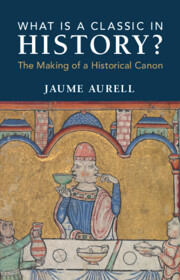Book contents
- What Is a Classic in History?
- What Is a Classic in History?
- Copyright page
- Contents
- Acknowledgements
- Introduction
- 1 The Conditions for Durability
- 2 The Dynamics of the Classic
- 3 The Inescapability of the Canon
- 4 The Canonical Function of Historical Genres
- 5 Genealogy as Double Agent
- Conclusions
- Selected Bibliography
- Index
2 - The Dynamics of the Classic
Published online by Cambridge University Press: 15 February 2024
- What Is a Classic in History?
- What Is a Classic in History?
- Copyright page
- Contents
- Acknowledgements
- Introduction
- 1 The Conditions for Durability
- 2 The Dynamics of the Classic
- 3 The Inescapability of the Canon
- 4 The Canonical Function of Historical Genres
- 5 Genealogy as Double Agent
- Conclusions
- Selected Bibliography
- Index
Summary
This chapter focuses on some specific features of the historical classic, offering a series of reflections to expand a debate on this complex topic. Based on some examples of the Western historiographical tradition, I discuss to what extent historians should engage the concept of the classic, as has been done for literary and artworks. I will argue that it is possible to identify a category of the classic text in historical writing. Because of their narrative condition, historical texts share some of the features assigned to literary texts such as durability, timelessness, universal meaningfulness, resistance to historical criticism, susceptibility to multiple interpretations, and ability to function as models. Yet, since historical texts do not construct imaginary worlds but try to achieve some realities external to the text, they also have to attain some specific features according to this referential content, such as the surplus of meaning, historical use of metaphors, effect of contemporaneity, and a certain appropriation of ‘literariness’.
Keywords
- Type
- Chapter
- Information
- What Is a Classic in History?The Making of a Historical Canon, pp. 87 - 137Publisher: Cambridge University PressPrint publication year: 2024



